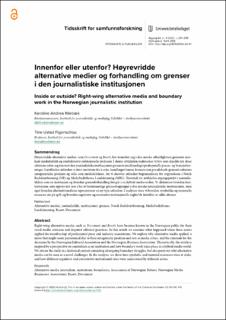| dc.contributor.author | Ihlebæk, Karoline Andrea | |
| dc.contributor.author | Figenschou, Tine Ustad | |
| dc.date.accessioned | 2023-04-24T09:10:49Z | |
| dc.date.available | 2023-04-24T09:10:49Z | |
| dc.date.created | 2022-11-21T15:23:42Z | |
| dc.date.issued | 2022 | |
| dc.identifier.citation | Tidsskrift for samfunnsforskning. 2022, 63 (4), 241-259. | en_US |
| dc.identifier.issn | 0040-716X | |
| dc.identifier.issn | 1504-291X | |
| dc.identifier.uri | https://hdl.handle.net/11250/3064435 | |
| dc.description.abstract | Høyrevridde alternative medier, som Document og Resett, har utmerket seg i den norske offentligheten gjennom markant mediekritikk og omdiskuterte redaksjonelle praksiser. I denne artikkelen undersøker vi hva som skjedde når disse aktørene søkte seg inn mot den journalistiske institusjonen gjennom medlemskap i profesjonelle presse- og bransjeforeninger. I artikkelen utforsker vi først motivene for å søke, handlinger kunne framstå som paradoksale grunnet søkernes antagonistiske posisjon og rolle som mediekritikere, før vi deretter utforsker begrunnelsene for avgjørelsene i Norsk Redaktørforening (NR) og Mediebedriftenes Landsforening (MBL). Teoretisk tar artikkelen utgangspunkt i journalistikken som en institusjon og hvordan grenseforhandling foregår i en hybrid medieverden. Vi diskuterer hvordan kontroversene som oppsto må sees i lys av kontinuerlige grensedragninger i den norske journalistiske institusjonen, men også hvordan alternativmediene representerer en ny type utfordrer. I analysen viser vi hvordan symbolske og materielleressurser sto på spill, og hvordan regulative og normative institusjonelle regler ble fortolket av ulike aktører.
Right-wing alternative media, such as Document and Resett, have become known in the Norwegian public for their vocal media criticism and disputed editorial practices. In this article we examine what happened when these actors applied for membership of professional press and industry associations. We explore why alternative media applied, a move that might seem paradoxical due to their antagonistic position and role as media critics, and the rationale for the decisions by the Norwegian Editorial Association and the Norwegian Business Association. Theoretically, the article is inspired by a perspective on journalism as an institution and how boundary work takes place in a hybrid media world. We situate the study in a historical context consisting of ongoing boundary struggles, but also point out why alternative media can be seen as a novel challenger. In the analysis, we show how symbolic and material resources were at stake, and how different regulative and constitutive institutional rules were understood by different actors. | en_US |
| dc.language.iso | nob | en_US |
| dc.publisher | Universitetsforlaget | en_US |
| dc.relation.ispartofseries | Tidsskrift for samfunnsforskning; | |
| dc.rights | Navngivelse-Ikkekommersiell 4.0 Internasjonal | * |
| dc.rights.uri | http://creativecommons.org/licenses/by-nc/4.0/deed.no | * |
| dc.title | Innenfor eller utenfor? Høyrevridde alternative medier og forhandling om grenser i den journalistiske institusjonen | en_US |
| dc.title.alternative | Inside or outside? Right-wing alternative media and boundary work in the Norwegian journalistic institution | en_US |
| dc.type | Peer reviewed | en_US |
| dc.type | Journal article | en_US |
| dc.description.version | publishedVersion | en_US |
| cristin.ispublished | true | |
| cristin.fulltext | original | |
| cristin.qualitycode | 1 | |
| dc.identifier.doi | http://dx.doi.org/10.18261/tfs.63.4.1 | |
| dc.identifier.cristin | 2077553 | |
| dc.source.journal | Tidsskrift for samfunnsforskning | en_US |
| dc.source.volume | 63 | en_US |
| dc.source.issue | 4 | en_US |
| dc.source.pagenumber | 241-259 | en_US |
| dc.relation.project | Norges forskningsråd: 295985 | en_US |

